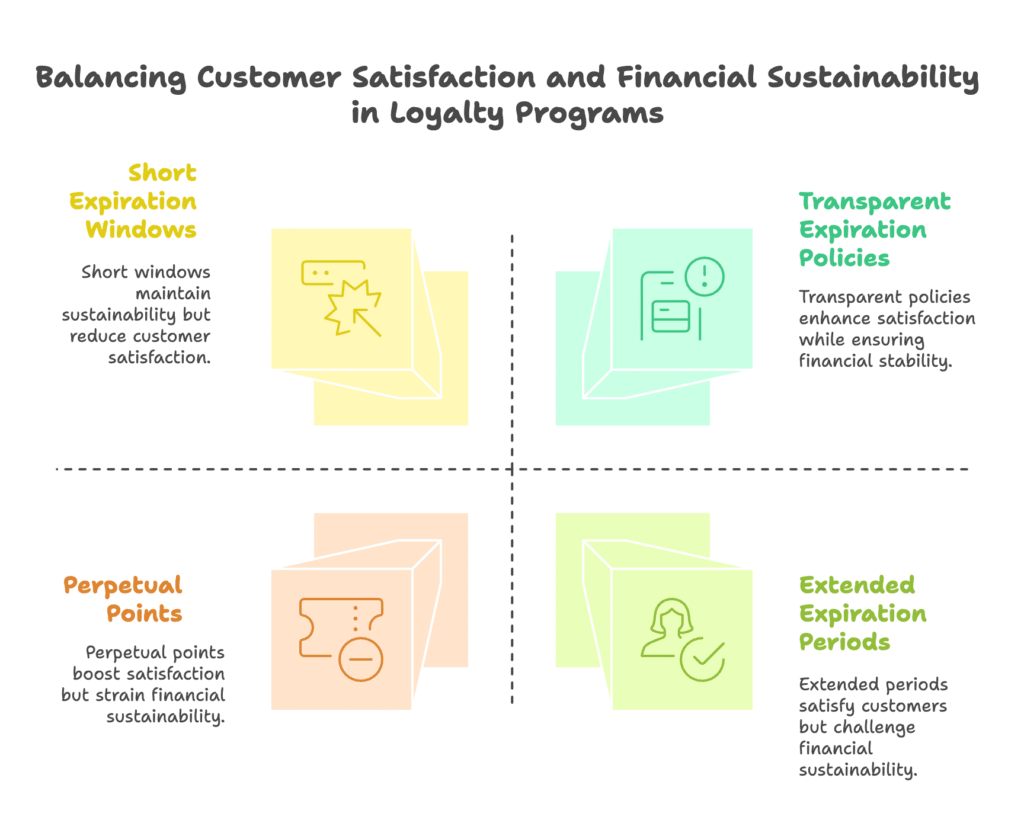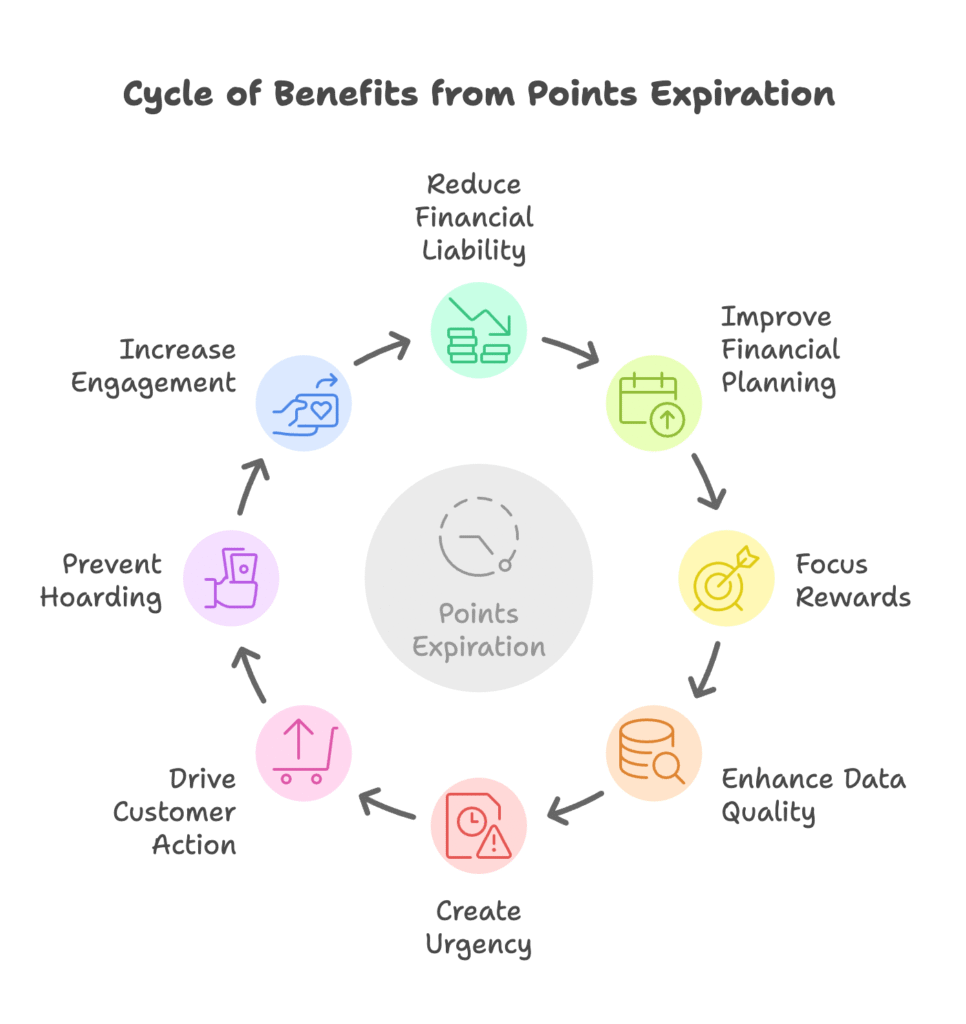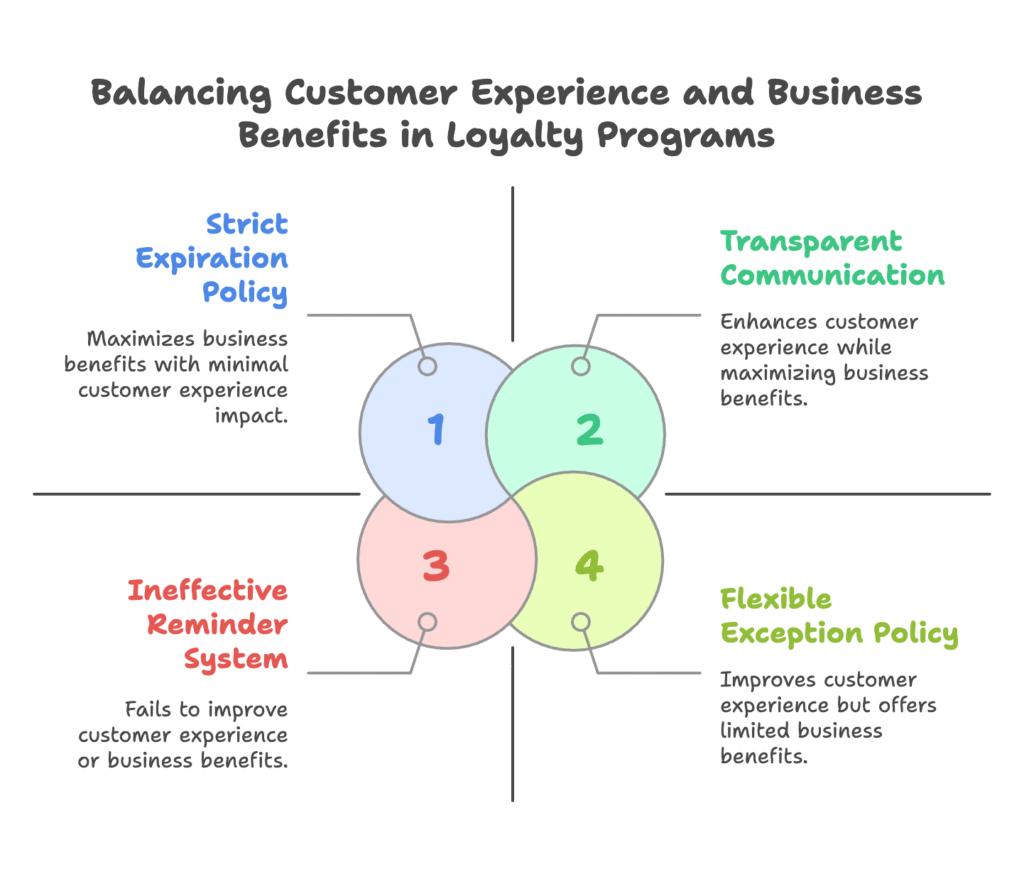Understanding Points Expiration in Loyalty Programs
That moment when a customer realizes their hard-earned loyalty points have vanished is the moment many brands lose a loyal advocate forever. Yet without expiration dates, loyalty programs can quickly become financial sinkholes for your Shopify store. This tension between keeping customers happy and maintaining a sustainable program isn’t just a dilemma—it’s the central challenge facing every e-commerce loyalty strategy today.
Points expiration policies walk a precarious tightrope. Set the deadline too short, and customers feel cheated. Make it too long, and you’re left carrying growing financial liability on your books. But what if there was a way to turn this potential friction point into an opportunity that actually strengthens customer relationships while protecting your bottom line?
In this guide, you’ll discover how to craft expiration strategies that drive urgency without driving customers away, manage financial liability without creating negative experiences, and implement technical solutions that make it all seamless on your Shopify store. Let’s transform what’s typically seen as a necessary evil into a powerful engagement tool.

Introduction to Points Expiration
Points expiration is more than just a time limit on rewards—it’s a crucial mechanism that keeps your loyalty program economically viable while encouraging consistent customer engagement. At its core, it’s a simple concept: after a predetermined period, unredeemed points become invalid. But its implications for your Shopify store stretch far beyond this basic definition.
Think of points expiration as the rhythm section of your loyalty program. Without it, customers might accumulate points indefinitely, creating unpredictable redemption patterns and financial liabilities that can spiral out of control. One Shopify merchant I worked with saw their unredeemed points liability grow to over $50,000 before implementing an expiration strategy—a significant burden for their growing business.
For customers, expiration dates create natural decision points. They transform the abstract “someday” of redemption into concrete “use it or lose it” moments that prompt action. This behavioral nudge is powerful—data shows that properly communicated expiration policies can increase redemption rates by 25-30% in the weeks leading up to expiration.
Across e-commerce, expiration strategies vary widely. Fast fashion brands often implement shorter windows (3-6 months) that match their rapid inventory turnover, while premium brands tend toward longer expiration periods (12-24 months) that reflect their customers’ more deliberate purchase cycles. Within the Shopify ecosystem specifically, most stores opt for the middle ground: points that expire after 12 months of inactivity or from date of issue.
The challenge isn’t whether to implement expiration—it’s how to structure it in a way that supports both customer satisfaction and program sustainability. Get it right, and expiration becomes nearly invisible to active customers while helping you maintain a healthy program. Get it wrong, and you’ll face frustrated customers and potential damage to your brand’s reputation.
Strategic Value of Expiration Policies
Beyond the obvious financial benefits, well-crafted expiration policies serve multiple strategic objectives for your Shopify store. They’re not just about cleaning house—they’re about creating valuable customer behaviors and protecting the perceived value of your rewards program.
First and foremost, expiration policies create purchase urgency. When customers receive that “Your points expire in 14 days” email, it triggers a powerful psychological response. Suddenly, those accumulated points feel like money about to be taken from their wallet. This perception motivates action in ways that regular promotional emails simply can’t match. One beauty brand on Shopify reported a 40% increase in return purchases after implementing expiration notifications—far exceeding their typical email campaign performance.
From a financial perspective, expiration policies allow you to manage the liability of unredeemed points. Without expiration, every point issued becomes a perpetual obligation on your books. This growing liability can impact everything from your financial statements to your ability to secure business funding. Expiration provides predictability, allowing you to forecast redemption patterns and manage program costs effectively.
Perhaps less obvious but equally important, expiration policies help maintain the perceived value of your program over time. When points never expire, they can begin to feel worthless—just another marketing gimmick rather than a meaningful reward. Paradoxically, reasonable expiration timeframes communicate that your points have real value worth using.
From the customer’s perspective, expectations about expiration vary significantly based on your industry, price point, and brand positioning. Luxury shoppers typically expect longer expiration periods that match their more infrequent purchase patterns, while value-focused customers are generally more accepting of shorter timeframes.
The key insight here is that customers don’t inherently object to expiration policies—they object to feeling surprised or misled by them. Transparency and fair notice are what truly matter. When customers understand the rules from the beginning and receive timely reminders, expiration can actually increase their appreciation of your program by prompting them to enjoy benefits they might otherwise have forgotten about.
Business Benefits of Implementing Points Expiration

Financial Advantages
The financial impact of implementing points expiration extends far beyond simply “cleaning the books.” It transforms the economics of your entire loyalty program, creating predictability where there was once uncertainty. Let’s break down exactly how this works—and why it matters for your Shopify store’s bottom line.
Unredeemed points represent a very real financial obligation. For every point sitting unused in customer accounts, your business carries a liability. Without expiration, this liability grows continuously, creating a potentially significant drag on your financial health. I’ve seen Shopify stores where unredeemed points liability represented 5-7% of their annual revenue—a surprisingly substantial sum.
Calculating this liability is straightforward: Multiply your total outstanding points by the monetary value per point. For example, if customers have collectively accumulated 1,000,000 points worth $0.01 each, your business carries a $10,000 liability. Expiration policies allow you to cap this liability at a predictable level rather than watching it grow indefinitely.
This predictability extends to financial planning and forecasting. With expiration policies in place, you can more accurately project redemption patterns and their impact on your margins. Rather than guessing at when (or if) customers might redeem accumulated points, you can anticipate redemption waves tied to expiration notices and plan inventory and cash flow accordingly.
Expiration also allows for more targeted resource allocation. Without it, your program rewards both active customers and those who haven’t engaged with your brand in years. With expiration, you naturally focus rewards on your most engaged customers—those who are actively purchasing and interacting with your store. This focus ensures your loyalty investment generates actual returns rather than rewarding one-time shoppers who may never return.
The data quality improvements are another often-overlooked benefit. Expiration policies help clean customer databases by identifying and removing stagnant accounts. This cleaning improves the accuracy of your analytics and segmentation efforts, giving you clearer insights into your actual active customer base. For Shopify stores running targeted marketing campaigns, this improved data quality translates directly into higher conversion rates and more effective spending.
Behavioral Economics Benefits
Beyond the balance sheet, points expiration taps into powerful principles of behavioral economics that can transform passive point collectors into active, engaged customers. This psychological dimension is where expiration truly proves its worth as a strategic tool rather than just a housekeeping function.
The most immediate behavioral benefit is the creation of urgency. When customers receive an expiration notice, it triggers what psychologists call “loss aversion”—the idea that people strongly prefer avoiding losses to acquiring equivalent gains. Put simply, the prospect of losing 500 points feels more motivating than the opportunity to earn 500 points. This asymmetry in how we value potential losses versus gains creates a powerful motivational force.
This urgency directly drives customer action. A well-timed expiration notification can prompt customers who haven’t visited your store in months to suddenly return and make purchases. One fashion retailer I consulted for saw a remarkable 52% activation rate on expiration notification emails—meaning over half of customers who received “Your points are about to expire” messages returned to either redeem points or make additional purchases to maintain their points balance.
Expiration policies also help prevent points hoarding behavior, where customers accumulate large balances but never redeem them. While hoarding might seem benign or even beneficial (after all, unredeemed points cost you nothing in the short term), it actually undermines program engagement. Customers who regularly redeem smaller rewards tend to place higher value on each point earned and remain more consistently engaged with your brand.
By encouraging regular redemption cycles, expiration keeps customers actively participating in your loyalty ecosystem. This participation creates a virtuous cycle: customers earn points, redeem rewards, experience the satisfaction of “getting something for free,” and are motivated to continue earning. Without this cycle of earning and burning, loyalty programs can lose their motivational power over time.
From a business perspective, these behavioral benefits translate into measurable improvements in key metrics. Properly implemented expiration policies typically increase overall redemption rates by 15-25%, improve program participation by 10-20%, and most importantly, drive additional purchases as customers “top up” their points balances to reach redemption thresholds before expiration.
Customer Experience Considerations

Potential Negative Impacts
Despite the clear business benefits, points expiration carries undeniable risks to the customer experience. Understanding these potential pitfalls is essential for designing an expiration strategy that enhances rather than damages your customer relationships.
The most obvious risk is customer frustration. When points expire, customers can feel that something they earned has been taken away unfairly. This perception of loss can be particularly damaging because loyalty programs are specifically designed to create positive emotional connections with your brand. One customer who loses a significant number of points can generate more negative word-of-mouth than ten satisfied customers generate positive reviews.
This frustration intensifies when customers compare your expiration policy to competitors with more lenient terms. If your closest competitor offers points that never expire (or have a substantially longer expiration period), your policy will inevitably suffer by comparison. This comparison effect is most pronounced in highly competitive niches where customers regularly shop across multiple brands and can easily switch their loyalty.
The risk of customer attrition is real. Data from several Shopify stores reveals that customers who experience points expiration are 2.3 times more likely to stop purchasing within the following six months compared to the average customer. This statistic highlights the potential downside of overly aggressive expiration policies.
Finding the right balance between strictness and flexibility is therefore crucial. Too short an expiration timeframe can alienate customers who shop less frequently but may have high lifetime value. Too many exceptions can create administrative headaches and potential abuse. The key is aligning your expiration timeframe with your typical customer purchase frequency. For example, if your data shows that loyal customers generally purchase every 4-6 months, an expiration policy of less than 12 months could penalize even your best customers.
This alignment extends to exception policies for loyal customers. Many successful Shopify stores implement tiered approaches where higher-value customers receive more generous expiration terms. Others build in “grace periods” where customer service can reinstate recently expired points—a policy that recognizes the outsized negative impact of strictly enforced expiration while still maintaining program economics.
The customer service implications also warrant careful consideration. Without proper planning, expiration policies can generate significant volumes of support requests from upset customers. These interactions are often emotionally charged and can strain support resources. Preparing your team with clear guidelines on when and how to make exceptions is essential for managing this potential friction point.
Strategies to Maintain Positive Customer Experience
The good news? With thoughtful implementation, points expiration doesn’t have to undermine customer satisfaction. In fact, it can actually enhance the perceived value of your loyalty program by encouraging active participation and regular rewards.
Transparent communication forms the cornerstone of a customer-friendly expiration strategy. From the moment customers join your program, the expiration policy should be clearly explained in simple, jargon-free language. This explanation should appear in your program terms, sign-up confirmation emails, and the loyalty dashboard in customer accounts.
Multiple reminder notifications before points expire are non-negotiable. Best practices suggest a sequence of notifications at 30 days, 14 days, and 7 days before expiration. These reminders should clearly state the number of points expiring, when they’ll expire, and what customers can do with those points before the deadline. The tone should be helpful rather than threatening—”Don’t miss out on rewards you’ve earned” rather than “Your points will be removed.”
Customers should also have easy access to their points status information. Your loyalty dashboard should clearly display not just total points but also any approaching expiration dates. This transparency prevents the unpleasant surprise of discovering points have expired without notice—a common source of customer frustration.
Beyond communication, creating specific redemption opportunities before expiration can transform potential negative experiences into positive ones. Special redemption events give customers compelling reasons to use their points. A “Double Redemption Value” weekend before major expiration dates can drive engagement while allowing customers to extract maximum value from their points.
“Use it or lose it” campaigns take this approach a step further by proactively suggesting specific redemption options based on customers’ point balances. These targeted suggestions remove the cognitive burden of figuring out how to use points and make redemption feel effortless.
For customers with small balances approaching expiration, offering low-point redemption options is particularly valuable. These might include small discounts, digital products with no shipping costs, or the ability to convert points to charitable donations. These options ensure that even customers with minimal engagement can extract some value rather than losing everything to expiration.
One Shopify beauty brand took this approach a step further by creating a “Points Rescue” program where customers with expiring points could convert them to a digital product (skin care guides) at a favorable rate. This creative solution transformed potential disappointment into unexpected delight—all while maintaining the integrity of their expiration policy.
Expiration Strategy Options for Shopify Stores
Time-Based Expiration Methods
When implementing points expiration on your Shopify store, you’ll need to choose between different time-based approaches. Each method has distinct advantages and challenges, with implications for both your technical setup and customer experience.
The most straightforward approach bases expiration on the date points were earned. With this method, points expire after a fixed timeframe—typically 12, 18, or 24 months—regardless of any subsequent customer activity. For example, points earned in January 2025 would expire in January 2026 under a 12-month policy.
This date-earned approach offers predictable liability management. You can forecast exactly when points will expire and plan accordingly. It also implements a first-in, first-out (FIFO) approach for redemption, where the oldest points are automatically used first. This natural prioritization helps customers maximize the value of their points without having to think about expiration dates for each individual earning event.
The primary drawback? This method doesn’t account for ongoing customer engagement. Active customers who regularly interact with your store but haven’t yet accumulated enough points for a desirable reward may still face expiration—potentially sending the wrong message about their value to your business.
The alternative is basing expiration on the last activity date. With this approach, any qualifying customer action—purchases, account logins, referrals, or other engagement events you define—resets the expiration clock for their entire points balance. Points only expire after a defined period of complete inactivity.
This activity-based approach rewards engagement rather than just purchasing. It recognizes that loyal customers might go through periods where they can’t make purchases but still remain engaged with your brand. By defining multiple qualifying activities, you create multiple pathways for customers to maintain their points balance.
Implementation in the Shopify environment requires careful consideration of your specific loyalty app capabilities. Most major Shopify loyalty apps (including Smile.io, LoyaltyLion, and Yotpo) support both expiration methods, but the specific settings and capabilities vary significantly between platforms.
Another consideration is the redemption sequence. With date-earned expiration, points are typically redeemed FIFO to maximize customer value. With activity-based expiration, this sequence is less critical since all points share the same expiration date, but you may still want to implement FIFO redemption as a customer-friendly practice.
Advanced Expiration Configurations
Beyond basic time-based methods, advanced expiration configurations offer sophisticated ways to align your expiration strategy with specific business objectives and customer segments. These approaches require more complex implementation but deliver more tailored results.
Tiered expiration strategies represent the gold standard for balancing program economics with customer experience. With this approach, different customer segments receive different expiration terms based on their value to your business. For example:
- Regular customers: Points expire after 12 months from earning
- Silver tier: Points expire after 18 months from earning
- Gold tier: Points expire after 24 months from earning
- Platinum tier: Points never expire as long as account remains active
This tiered approach rewards your most valuable customers with more flexible terms while still maintaining reasonable expiration policies for occasional shoppers. It creates another tangible benefit of achieving higher loyalty tiers and can significantly increase program participation as customers work to reach tiers with more favorable policies.
You can also use expiration as a tier maintenance mechanism. For example, you might implement a policy where customers must earn or redeem a minimum number of points annually to maintain their tier status. This approach creates regular engagement cycles and prevents the situation where customers reach a high tier and then disengage from your brand.
Technical implementation of tiered expiration typically requires more advanced Shopify loyalty apps. LoyaltyLion and Yotpo offer the most robust support for tiered expiration strategies, while some simpler apps may only support universal expiration rules. Before selecting a loyalty app, verify that it can support your desired expiration configuration.
Hybrid approaches combine multiple expiration triggers to create more sophisticated systems. For example, you might implement a policy where points expire after either 18 months from earning OR 12 months of inactivity, whichever comes first. This hybrid approach provides protection against both point hoarding and inactive accounts.
Seasonal or campaign-based expiration strategies take this concept even further. Rather than using fixed timeframes, these approaches align expiration with your business cycle and marketing calendar. For example, a fashion retailer might issue special “Summer Collection” points that expire at the end of the season, creating natural urgency tied to their merchandise cycles.
Perhaps the most sophisticated approach is aligning expiration with your customer purchase frequency. Analysis of your customer data may reveal natural purchasing cycles—for example, customers who typically purchase every 4-6 months. Setting your expiration timeframe at 2-3x this frequency ensures that even customers who shop at their normal cadence never experience expiration, while still allowing you to clean out truly inactive accounts.
Implementation in Shopify
Technical Setup
Implementing points expiration in your Shopify store requires careful technical consideration. The right setup ensures your expiration strategy works flawlessly while minimizing customer friction and administrative overhead. Let’s walk through the process step by step.
Your first decision is selecting a loyalty app that supports your desired expiration features. While many Shopify loyalty apps offer basic expiration functionality, their capabilities vary significantly. Here’s what to evaluate:
- Expiration flexibility: Can the app support your chosen approach (date-earned, activity-based, or hybrid)?
- Notification capabilities: Does it offer automated expiration reminders? How customizable are these notifications?
- Customer interface: How clearly does it display expiration information to customers?
- Reporting: Does it provide insights on expiring points and redemption patterns?
- Integration capabilities: Does it connect with your email marketing platform for coordinated communications?
Based on these criteria, Yotpo, LoyaltyLion, and Smile.io typically offer the most robust expiration capabilities for Shopify stores. For stores with simpler needs, Rise.ai and S Loyalty also provide basic expiration functionality at lower price points.
Once you’ve selected your app, configuration involves several key steps. First, access the expiration settings within your loyalty app dashboard. This is typically found under “Program Settings” or “Points Configuration.” Here, you’ll set your fundamental expiration parameters:
- Expiration timeframe (12 months, 18 months, etc.)
- Expiration trigger (from date earned, from last activity, or hybrid)
- Qualifying activities that reset the expiration clock (for activity-based expiration)
- Any tier-specific expiration rules (if using a tiered approach)
After setting your basic parameters, test your expiration functionality thoroughly before going live. Create test customer accounts, award points, and manipulate dates to verify that expiration works as expected. Pay particular attention to edge cases, such as how the system handles points earned through different activities or how redemptions affect expiration dates.
Automated notification setup is a critical component of your technical implementation. Most higher-end loyalty apps allow you to configure a sequence of reminder emails at specified intervals before expiration (typically 30, 14, and 7 days). For each notification, you’ll need to:
- Create the email template with clear messaging about the expiring points
- Set the timing trigger relative to the expiration date
- Configure any segmentation rules (e.g., minimum points threshold for notifications)
- Enable tracking to monitor open and conversion rates
For more sophisticated notification strategies, consider integrating your loyalty app with Klaviyo. This integration allows for more personalized expiration notifications based on customer segments, purchase history, and engagement patterns. With Klaviyo, you can create dynamic content blocks that show personalized redemption suggestions based on each customer’s points balance and preferences.
Your notification templates should strike a balance between creating urgency and providing value. The most effective templates include:
- Clear subject lines that mention expiring points
- Precise information about how many points are expiring and when
- Specific redemption suggestions based on the customer’s points balance
- Direct links to the redemption page or storefront
- A secondary call-to-action for customers with insufficient points to earn more
Customer-Facing Elements
The customer-visible aspects of your expiration implementation are just as important as the backend setup. How expiration appears to customers directly impacts their perception of your program’s fairness and value. Done right, these elements create clarity and motivation rather than confusion or frustration.
The central component is displaying points status and expiration dates in customer accounts and loyalty dashboards. This information should be immediately visible when customers log in, not buried several clicks deep. The display should clearly show:
- Total available points balance
- Points expiring soon (within the next 30-60 days) highlighted separately
- Exact expiration dates for points batches
- What the points can be redeemed for (redemption options)
Visualizing approaching expiration dates enhances clarity and creates subtle urgency. Consider implementing a color-coded system where points expiring within 30 days appear in red, within 60 days in yellow, and others in green. Some advanced loyalty apps also offer progress bar visualizations showing how much time remains before expiration—a particularly effective approach for driving action.
Mobile and desktop experiences require different approaches due to screen size constraints. On desktop, you have space to display detailed expiration information in a sidebar or dedicated loyalty dashboard. On mobile, prioritize simplicity with a prominent “Expiring Soon” alert and one-tap access to more detailed information. Test both experiences thoroughly, as many customers primarily interact with loyalty programs via mobile devices.
Your program terms and conditions must clearly explain expiration rules to meet both legal requirements and customer expectations. This documentation should include:
- Plain-language explanation of when and how points expire
- Examples illustrating the expiration policy in action
- Any exceptions or special cases (such as tier-based expiration)
- How customers will be notified about approaching expiration
- Any redemption minimums or restrictions
Include these expiration details in your FAQ section as well, addressing common questions like “Can expired points be reinstated?” and “How can I check when my points expire?” Anticipating these questions prevents customer service inquiries and demonstrates transparency.
Legal compliance considerations vary by region, but generally revolve around clear disclosure and fair treatment. In some jurisdictions, like California and the European Union, specific regulations govern loyalty program expiration policies. These typically require conspicuous disclosure of expiration terms before enrollment and reasonable timeframes that don’t unfairly deprive customers of earned benefits. Consult with legal counsel familiar with your market regions to ensure your expiration policy meets all applicable requirements.
Communication and Promotion Strategies
Proactive Customer Communication
Effective communication transforms points expiration from a potential frustration into an engagement opportunity. The right message at the right time can drive action while reinforcing the value of your loyalty program.
Your expiration notification strategy should follow a carefully planned sequence for maximum effectiveness. Research shows that a three-touch approach generates optimal results:
- Early notice (30 days before expiration): Informational in tone, focusing on education and providing ample time for customers to plan redemption.
- Action reminder (14 days before expiration): More urgent messaging that suggests specific redemption options based on the customer’s points balance.
- Last chance alert (7 days before expiration): Creates strong urgency with direct calls to action and emphasis on the impending deadline.
The content of these messages significantly impacts their effectiveness. Focus on driving action rather than simply announcing expiration. Compare these two approaches:
❌ “Your points will expire on June 15th.” (Passive statement focused on loss)
✅ “Redeem your 500 points for a free product before June 15th!” (Active statement focused on benefit)
The second approach transforms the expiration notice from a negative reminder into a positive opportunity. It emphasizes what customers stand to gain by acting rather than what they’ll lose by not acting—a subtle but powerful psychological shift.
A multi-channel approach maximizes reach and impact. While email remains the primary channel for expiration notifications (with average open rates of 35-45% for well-crafted expiration alerts), supplementing with SMS and in-app notifications can increase visibility by 30-40%. For particularly high-value customers or those with substantial expiring points balances, consider adding personalized outreach through customer service channels.
Staff training for expiration policies is often overlooked but critically important. Your customer service team needs clear guidelines on:
- Explaining expiration policies in simple, non-technical terms
- Handling common customer questions and objections
- When and how to make exceptions for point reinstatement
- Suggesting alternative solutions for customers with expired points
Developing clear scripts for these scenarios ensures consistent handling while empowering staff with appropriate flexibility. The goal isn’t rigid enforcement of rules but rather using expiration as a touchpoint to reinforce program value and encourage engagement.
Consider implementing a limited “goodwill reinstatement” policy for first-time expirations or high-value customers. This one-time courtesy can transform a negative experience into a positive one, especially when combined with education about how to prevent future expiration. Data shows that over 70% of customers who receive a one-time points reinstatement become more engaged with the program afterward—a counterintuitive but powerful finding.
Turning Expiration into Opportunity
Forward-thinking Shopify merchants don’t just manage expiration—they leverage it as a marketing opportunity. Strategic approaches can transform imminent expiration from a potential negative into a powerful conversion driver.
Creating urgency-based promotions around expiration periods capitalizes on customers’ desire to maximize value. Limited-time redemption bonuses are particularly effective: “Use your points before June 15th and get 25% more value!” This approach acknowledges the approaching deadline while creating a positive incentive that feels like a special opportunity rather than just avoiding a loss.
Special offers that combine points and purchases create interesting opportunities for increasing order value. For example: “Your 500 points are expiring soon! Combine them with any purchase over $50 to receive a premium gift.” This approach not only drives redemption but also generates additional revenue—a win-win outcome that makes economic sense for both your business and your customers.
Exclusive redemption options for expiring points create a sense of special access. Consider creating limited-time redemption opportunities that appear only for customers with expiring points. These might include early access to new products, exclusive bundles, or special services not available for regular purchase. The exclusivity adds perceived value beyond the monetary worth of the points.
Leveraging expiration data for targeted marketing represents another opportunity dimension. By analyzing your customer base for approaching expirations, you can identify valuable segments:
- High-point balances with approaching expiration (VIP re-engagement opportunities)
- Customers just below redemption thresholds (top-up purchase opportunities)
- Formerly active customers with long-dormant points (win-back campaign candidates)
For each segment, tailored offers based on points balances and previous behaviors will significantly outperform generic communications. For example, customers just below a redemption threshold might receive offers emphasizing how few additional points they need to earn through a purchase, while high-balance customers might receive exclusive redemption options available only to them.
Perhaps most interesting are re-engagement campaigns for customers with already expired points. Rather than writing these customers off, consider “points revival” campaigns that offer to reinstate a portion of expired points with a qualifying purchase. Data shows these campaigns can achieve 3-5x higher conversion rates than standard win-back offers, particularly when the reinstated points immediately qualify customers for a meaningful reward.
Measuring and Optimizing Your Strategy
Key Performance Metrics
Implementing points expiration is just the beginning. To truly maximize its effectiveness, you need to systematically measure performance and continuously refine your approach based on data-driven insights.
Start by tracking program economics through key financial metrics. The most fundamental is liability reduction through expiration—the total point value removed from your books through your expiration policy. This metric directly quantifies the financial benefit of your expiration strategy.
However, liability reduction tells only part of the story. You should also measure changes in redemption patterns, particularly in the weeks before major expiration dates. What percentage of potentially expiring points are redeemed rather than forfeited? High redemption rates before expiration indicate effective communication, while low rates may suggest notification issues or redemption barriers.
Calculating program ROI and cost efficiency provides a comprehensive view of expiration’s impact. Compare program costs before and after implementing expiration, accounting for both direct costs (point values redeemed) and indirect benefits (increased purchase frequency, higher average order value from expiration-driven activity). Most mature Shopify loyalty programs see cost efficiency improvements of 15-25% after implementing well-designed expiration policies.
Customer behavior metrics reveal the engagement impact of your expiration strategy. Start by measuring engagement rate changes after implementation. Has overall program participation increased? Are customers checking their points balances more frequently? The most successful implementations show 20-30% increases in dashboard logins and redemption activity.
Redemption spike patterns before expiration dates provide valuable insights into notification effectiveness. Typically, you should see distinct spikes 7-14 days after each notification batch, with the largest spike following your final reminder. If these patterns don’t appear, your notifications may not be reaching customers or compelling action.
Perhaps most importantly, measure the impact on purchase frequency and average order value. Effective expiration strategies don’t just prompt redemption—they drive additional purchases as customers “top up” points or make incremental purchases when redeeming. One apparel retailer found that customers receiving expiration notifications spent an average of 40% more in the 30 days following notification compared to their typical monthly spend.
Testing and Refinement
No expiration strategy is perfect from the start. Continuous testing and refinement are essential for optimizing both business outcomes and customer experience.
A/B testing different expiration approaches with customer segments provides concrete data on what works best for your specific audience. Consider testing variables such as:
- Expiration timeframes (12 months vs. 18 months vs. 24 months)
- Expiration triggers (date-earned vs. activity-based)
- Notification timing sequences (30/14/7 days vs. 60/30/15 days)
- Notification content (loss-framed vs. benefit-framed messages)
When conducting these tests, ensure you’re measuring both business metrics (redemption rates, additional purchases) and customer experience metrics (satisfaction scores, support ticket volumes). The goal is finding the balance that optimizes both dimensions.
Testing communication strategies for effectiveness is equally important. Subject line variations can dramatically impact open rates for expiration notifications, while different calls to action influence conversion rates. One beauty retailer increased expiration notification effectiveness by 35% simply by changing their subject line from “Your points are expiring” to “Last chance to use your rewards!”
Evaluating customer satisfaction with different policies provides the qualitative perspective needed to complement your quantitative metrics. Use post-redemption surveys, Net Promoter Score (NPS) tracking, and support ticket analysis to understand the experiential impact of your expiration strategy. Pay particular attention to any correlation between expiration experiences and subsequent purchase behavior.
Establishing an ongoing optimization framework ensures continuous improvement rather than one-time adjustments. Implement a regular review process—typically quarterly for new programs and semi-annually for mature ones—where you systematically evaluate:
- Expiration policy performance against financial targets
- Customer feedback and satisfaction metrics
- A/B test results from the previous period
- Competitive landscape changes and industry trends
Benchmarking against competitors and industry standards provides context for your results. While expiration policies vary widely, certain patterns emerge by industry. Fashion retailers typically implement 12-18 month expiration periods, while higher-ticket categories like home goods or electronics often extend to 24-36 months to match longer purchase cycles. Understanding these norms helps ensure your policy aligns with customer expectations for your category.
Perhaps most importantly, incorporate customer feedback into policy refinements. Your customers will tell you—directly through feedback and indirectly through behavior—what works and what doesn’t. The most successful loyalty programs view expiration policy as an evolving component that requires regular adjustment based on changing customer expectations and business needs.
Ultimately, the perfect expiration strategy doesn’t exist in isolation—it’s the one that best balances your specific business objectives with your unique customer expectations. By measuring rigorously, testing continuously, and refining thoughtfully, you can transform points expiration from a necessary administrative function into a strategic asset that drives both engagement and profitability.
References
- Shopify Blog. “4 Examples of Leading Points Programs To Inspire Your Own.” https://www.shopify.com/blog/points-programs
- easyPoints. “Expiration – easyPoints features.” https://www.easypoints.jp/deep-dives/expiration
- Yotpo Support. “Setting up Points Validation and Expiration.” https://support.yotpo.com/docs/setting-up-points-expiration
Ready to supercharge your Shopify store’s sales with perfectly optimized discount codes and loyalty strategies? Growth Suite is a Shopify app that helps you track visitor behavior, predict purchase intent, and present personalized, time-limited offers to boost conversions. Its intelligent approach ensures you’re not just giving discounts away—but strategically using them to drive sales from customers who might otherwise leave. Install it with a single click and start seeing results with your new, optimized loyalty program!




